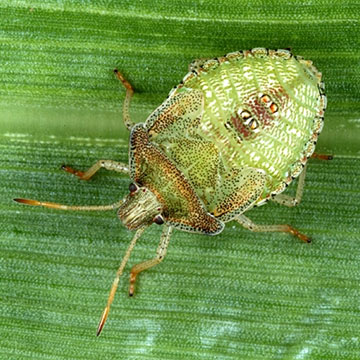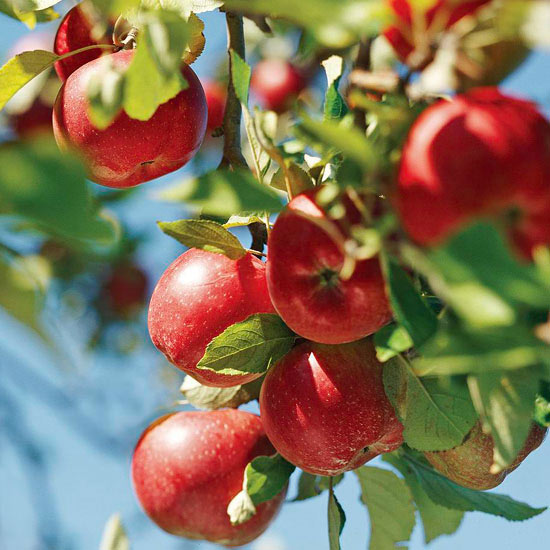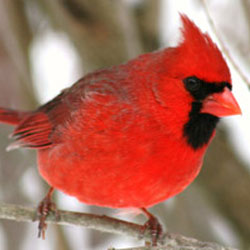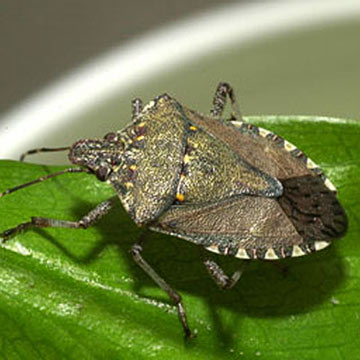





 Photo by Herb Pilcher, USDA Agricultural Research Service, Bugwood.org
Photo by Herb Pilcher, USDA Agricultural Research Service, Bugwood.org
Stink bugs prey on tender young foliage and fruit. They blemish leaves and succulent fruit and when present in large numbers stink bugs will render foliage unsightly and fruit inedible.
Stink bugs pierce the flesh of leaves and the skin of fruit to extract nutrient rich sap from the plant. Infested fruit develops hard calluses around the feeding area. If the fruit is young when stink bugs invade, its subsequent growth will be deformed. Leaves that are heavy infested may become distorted or scorched.
On a positive note, stink bugs do not cause harm to humans, although they are annoying when they make their way into homes and noisily fly about. Stink bugs will not reproduce inside homes or cause damage. Stink bugs are attracted to homes in fall when search for a protected place to overwinter. Prevent infestation by sealing cracks around windows, doors, siding, and anywhere else the bugs might gain entrance.
continue reading belowStink bugs are shield-shaped, think of the shape of a shield from medieval times, and about ¾ of an inch long. The bugs are commonly green or brown with yellow, red, or orange markings on the edges of their wings. As their name implies, stink bugs release foul smelling chemicals when they are disturbed.
 Apples are often damaged by stink bugs. The fruit develops unsightly callused areas.
Apples are often damaged by stink bugs. The fruit develops unsightly callused areas.
Stink bugs feed on a wide variety of plants. They will dine on leaves, fruits, flowers, and stems of trees, shrubs, vines, herbaceous perennials, and annuals. Their feeding damage has a significant impact on fruit and vegetable plants when they render the produce unsightly.
Yellow or white blotches on leaves is a possible indication of stink bug feeding. The leaves may also become distorted and take on a scorched appearance. Stink bug feeding on fruits and vegetables often results in small sunken areas surrounding by callusing in the case of apples and other thick-skinned fruits or discoloration on fleshy tomatoes.
 A thriving songbird population will devour stink bugs.
A thriving songbird population will devour stink bugs.
Stink bugs have several natural predators, including several species of songbirds. Encourage birds to visit your yard and garden by providing a water source and nesting sites in the form of native trees and shrubs. The birds will feast on stink bugs as well as other garden pests.
Limit weeds and overgrown areas in your yard to eliminate stink bug nesting sites. For a good natural balance of pests and predators, regulate overgrown areas to a space far removed from the manicured part of the landscape.
Finally, if stink bugs become prolific and cause extensive damage, turn to an insecticide. Choose a product that is appropriate for stink bug control on the plant that the bugs are infesting. Follow label directions carefully to avoid harming beneficial insects.
 Brown marmorated stink bug. Photo by David R. Lance, USDA APHIS PPQ, Bugwood.org
Brown marmorated stink bug. Photo by David R. Lance, USDA APHIS PPQ, Bugwood.org
A relatively new species of stink bug to North America, the brown marmorated stink bug is becoming prevalent and is causing extensive damage to food crops across the United States. To distinguish the brown marmorated stink bug from other stink bugs, look for light brown bands on the antennae and dark brown bands on the front pair of wings. It feasts on apples, peaches, berries, and sweet corn, as well as many other food crops. Control for brown marmorated stink bug is the same as other stink bugs. See the management and control section above.
Copyright © www.100flowers.win Botanic Garden All Rights Reserved